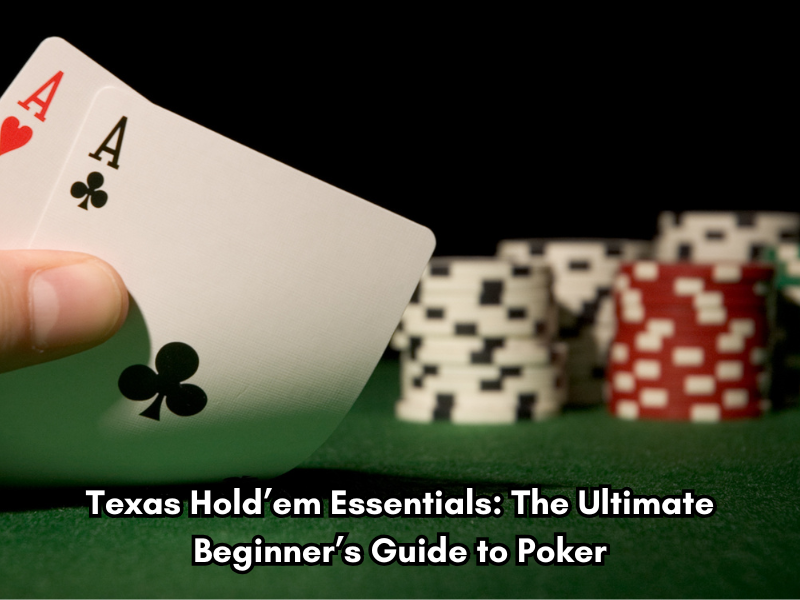

Welcome to the world of Texas Hold’em Poker, a game that has captured the hearts and minds of card players everywhere. Whether you’re a complete novice or a seasoned player, understanding the basics of Texas Hold’em is essential for success. In this guide, we’ll explore the core elements of the game, from the rules and hand rankings to betting strategies and common mistakes to avoid. Let’s dive right in!

Texas Hold’em stands tall as the most popular variant of poker, both in the glitzy casinos of Las Vegas and the virtual tables of online poker rooms. Its appeal lies in its simplicity, strategic depth, and the perfect blend of luck and skill it offers. Before you start envisioning yourself winning a World Series of Poker bracelet, you need to grasp the fundamentals.
Let’s start by breaking down the essential elements of Texas Hold’em.
The Game of Texas Hold’em
Texas Hold’em is a community card poker game that accommodates anywhere from two to ten players. It uses a standard 52-card deck, and each player receives two private cards known as “hole cards.” These hole cards, in combination with five community cards, make up your final hand.
The Objective of the Game
In simple terms, the aim of Texas Hold’em is to win chips. You can achieve this by either having the best hand at the showdown or by using strategic betting to make your opponents fold their hands. Ultimately, the goal is to outlast your rivals and accumulate their chips.
Before we get into the nitty-gritty of gameplay, let’s talk about hand rankings. In Texas Hold’em, hands are ranked from highest to lowest, determining the winner in each hand. Here’s a quick rundown:
Royal Flush
At the top of the hierarchy is the Royal Flush, featuring the A, K, Q, J, and 10 of the same suit. It’s the unbeatable hand in poker.
Straight Flush
A Straight Flush consists of any five consecutive cards of the same suit. For example, 8-9-10-J-Q of hearts.
Four of a Kind
This hand includes four cards of the same rank, like four Aces.
Full House
A Full House is made up of Three of a Kind and a Pair. For instance, three 7s and two 5s.
Flush
A Flush comprises any five cards of the same suit, even if they’re not in consecutive order.
Straight
A Straight is any five consecutive cards of different suits.
Three of a Kind
This hand has three cards of the same rank, such as three Jacks.
Two Pair
Two Pair includes two sets of pairs, like two 10s and two 6s.
One Pair
One Pair is a hand with a single set of pairs, such as two Queens.
High Card
If no player has a hand from the categories above, the winner is determined by the highest card in their hand.
Understanding these hand rankings is essential because they determine the strength of your hand in Texas Hold’em.
Position is a pivotal factor in poker, and Texas Hold’em is no exception. Your position concerning the dealer button significantly influences your strategic decisions, and it can be divided into three main positions: early, middle, and late.
Early Position
Players in early position are among the first to act in each betting round. It’s a cautious position because you have limited information about your opponents’ intentions. Typically, early-position players should play tight and focus on strong starting hands.
Middle Position
Middle position offers more information than the early position but less than late position. Players here can expand their starting hand selection, but they should still proceed with caution.
Late Position
Late position, also known as the “button,” is the most favorable position. Players in late position act last in the betting rounds, giving them more insight into their opponent’s moves. This position allows for a broader range of playable hands and opportunities to steal blinds.
Understanding and utilizing your position effectively is a key aspect of mastering the Texas Hold’em strategy.
Texas Hold’em unfolds over multiple betting rounds, each with its unique dynamics. Let’s explore these betting rounds and the actions available to players.
Preflop
The game kicks off with two players posting forced bets called the small blind and the big blind. Each player is dealt two hole cards, and the action starts with the player to the left of the big blind.
Flop
Following the pre-flop betting round, the dealer reveals the first three community cards, known as the “flop.” Another round of betting ensues, starting with the player to the left of the dealer button.
Turn
The fourth community card, known as the “turn,” is revealed, and another round of betting takes place.
River
The fifth and final community card, the “river,” is revealed, marking the final round of betting.
Showdown
A showdown happens if numerous players remain after the river betting round. Players reveal their hole cards, and the player with the best hand claims the pot.
Comprehending the available actions in each betting round is essential for making informed decisions at the poker table.
In Texas Hold’em, blinds and antes serve as forced bets that contribute to the pot and stimulate action. Let’s delve deeper into these concepts.
Blinds
Blinds are obligatory bets placed by two players to the left of the dealer button at the start of each hand. The player immediately to the left posts the small blind, while the next player posts the big blind. Blinds rotate clockwise after each hand.
Blinds serve two primary purposes: they create an initial pot to play for and ensure that there is always something at stake in every hand, motivating players to participate.
Antes
Antes are akin to blinds but are posted by all players at the table before each hand, regardless of their position. While blinds are more common in Texas Hold’em, antes are often used in games like Seven Card Stud.
Understanding blinds and antes is essential, as they impact the betting dynamics and influence your decisions during each hand.
One of the most critical aspects of Texas Hold’em is selecting the right starting hands. Your starting hand represents the bedrock of your strategy, and making the wrong choices can lead to costly errors. Let’s dive into the basics of starting hand selection.
The Significance of Starting Hands
Your choice of starting hands determines your potential to form strong hands on the flop, turn, and river. Starting with a robust hand increases your chances of winning the pot.
Premium Hands
Premium hands are the cream of the crop. They encompass pairs of Aces (AA), Kings (KK), Queens (QQ), and Jacks (JJ), as well as Ace-King (AK) suited.
The Impact of Position
Your position at the table should influence your starting hand selection. In an early position, it’s wise to play fewer, stronger hands, while in a late position, you can widen your range.
Hand Ranges
Rather than fixating on specific hands, professional players think in terms of hand ranges. A hand range is a group of hands you might consider playing based on your position and the table dynamics.
Common Mistakes
Novice players often make the mistake of playing too many hands, especially weak ones. This can lead to frequent losses and a dwindling chip stack. To avoid this, stick to a disciplined starting hand strategy.
By understanding the importance of starting hands and implementing a well-thought-out strategy, you can significantly improve your Texas Hold’em game.
The community cards in Texas Hold’em are essential to the game’s dynamics. As they are revealed, they shape the potential hands that players can make. Let’s explore the community cards and the art of board reading.
The Flop, Turn, and River
In Texas Hold’em, the flop consists of three community cards, followed by the turn (one card) and the river (one card). These cards are revealed in sequence after the preflop betting round.
Reading the Board
To succeed in Texas Hold’em, you must become proficient at reading the board. This means assessing the possible hand combinations that can be made using the community cards in combination with your hole cards.
Example: Board Reading
Suppose the flop reveals the 5 of hearts, 8 of spades, and 10 of diamonds. The turn card is the 9 of clubs, and the river card is the 2 of hearts. By analyzing these community cards, you can determine the possible hands your opponents might hold. For instance, someone could have a straight with 6-7 in their hole cards.
Mastering board reading is crucial for making informed decisions and gaining an advantage over your opponents.
Now that you’ve gained a solid understanding of the basics, let’s explore some common betting strategies employed by Texas Hold’em players.
Value Betting
Value betting involves making bets with the intention of extracting value from your opponents when you have a strong hand. The goal is to entice your opponents to call with weaker hands.
Bluffing
Bluffing is a cornerstone of poker strategy. It involves making bets or raises with the intention of convincing your opponents that you have a stronger hand than you actually do. Successful bluffing can lead to winning pots with weaker hands.
Pot Odds
Pot odds are the ratio of the current size of the pot to the size of the bet you need to call. Understanding pot odds helps you make mathematically sound decisions when faced with drawing hands.
Example: Pot Odds
If the pot contains $100 and your opponent bets $20, you would need to call $20 to potentially win $120 ($100 in the pot plus your opponent’s $20 bet). This means you’re getting pot odds of 6 to 1, making a call profitable if your drawing odds are better than 6 to 1.
By incorporating these betting strategies into your game, you can manipulate the action and maximize your chances of winning.
Even the best players make mistakes, but learning from these errors is key to improvement. Let’s highlight some common mistakes that novice players should avoid.
Playing Too Many Hands
One of the most common rookie blunders is playing too many hands. This leads to entering pots with weak hands, resulting in frequent losses.
Ignoring Position
Failing to consider your position at the table can be detrimental. Playing weak hands out of position can put you at a significant disadvantage.
Overvaluing Hands
Novice players often overvalue mediocre hands, leading to over-commitment of chips to pots they should have folded from.
Neglecting Pot Odds
Understanding pot odds is essential for making informed decisions when drawing too strong hands. Ignoring pot odds can lead to costly mistakes.
Emotional Play
Poker requires discipline and emotional control. Allowing your emotions to guide your actions can result in poor decisions and financial losses.
Lack of Bankroll Management
Effective bankroll management is crucial for long-term success. Failing to manage your bankroll can result in going broke, even if you possess strong poker skills.
By recognizing and avoiding these common mistakes, you can strengthen your Texas Hold’em game and reduce the learning curve.
Improvement in Texas Hold’em, like any skill, comes with practice and continuous learning. Let’s explore some valuable resources to help you along your poker journey.
Online Poker Rooms
Numerous online poker rooms offer a variety of games and stakes, making it easy to practice and refine your skills. Many sites also provide free-play options for beginners.
Home Games
Organizing or participating in friendly home poker games can be an enjoyable way to practice and gain experience. It’s a relaxed environment where you can apply your knowledge without the pressure of a casino setting.
Books and Articles
There are countless poker books and articles written by experienced players and strategists. These resources cover a wide range of topics, from basic strategy to advanced concepts.
Courses and Tutorials
Many websites and poker schools offer courses and tutorials for players of all skill levels. These structured programs provide a systematic approach to improving your game.
Poker Forums and Communities
Engaging with poker forums and communities online allows you to connect with other players, discuss strategy, and learn from experienced pros.
Remember that mastering Texas Hold’em is an ongoing process. By dedicating time to practice and absorbing knowledge from various sources, you can steadily enhance your skills and become a formidable player.

In conclusion, mastering the basics of Texas Hold’em is the foundation upon which successful poker careers are built. By understanding the core concepts, hand rankings, positions, and betting strategies, you’ll gain a significant advantage at the poker table.
Avoiding common mistakes and practicing regularly will further sharpen your skills. Embrace the journey of continuous improvement, and remember that poker is not just a game of chance but a game of skill, strategy, and psychological prowess.
So, whether you’re aiming to compete at the highest levels of poker or simply looking to enjoy a casual game with friends, the knowledge you’ve gained here will serve as your guiding light in the exciting world of Texas Hold’em. Good luck, and may the cards always be stacked in your favor!